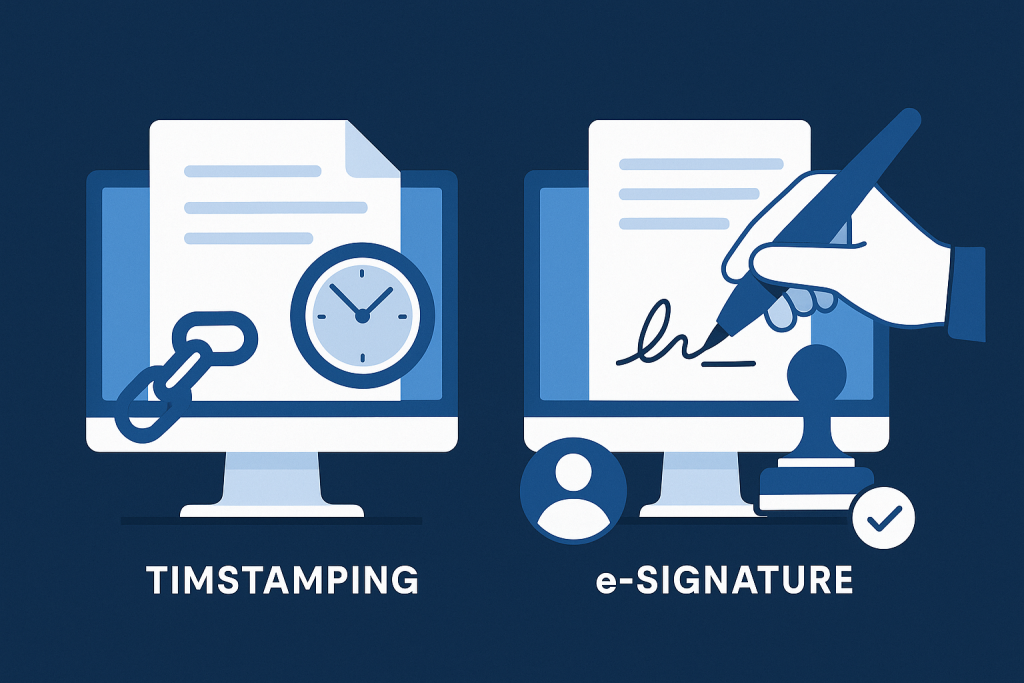
In a world where digital agreements, creative works, and business records fly across platforms daily, proving who did what, and when has never been more important.
Two popular tools for securing digital actions are:
- eSignatures, which record a person’s intent to sign
- Digital timestamps, which prove when a file existed or was finalized
While they seem similar, they serve very different purposes—and understanding when to use each can save you time, protect your work, and even help win disputes.
What Is Timestamping?
Timestamping is a method for proving that a file or piece of data existed at a specific moment in time, without revealing its contents. VerifyFirst does this by:
- Hashing your file using SHA-256 (a cryptographic fingerprint)
- Recording that hash on the Bitcoin blockchain, creating a public, irreversible timestamp
- Providing a verification link and optional tools like cover letters or PDF summaries
This is powerful for creators, businesses, and professionals who want undeniable proof that they had something first—before sending, sharing, or publishing it.
Learn how timestamping works →
What Is an eSignature?
An electronic signature is a digital way to capture someone’s agreement to a document. Popular platforms like DocuSign, Adobe Sign, and HelloSign let users “sign” forms online.
While most are legally valid under laws like the eIDAS Regulation (EU) and ESIGN Act (U.S.), the security and verification quality vary depending on the platform.
Many “click-to-sign” systems do not verify identity, which leaves a gap in trust—especially in high-risk or compliance-heavy industries.
Where eSignatures Fall Short
Let’s break down the common problems with standard eSignatures:
1. Weak Identity Verification
Most eSignatures don’t require anything beyond an email. A report by the UK Law Society (2021) noted:
“Most basic e-signatures provide minimal assurance of signer identity.”
Unless you use a high-trust platform with multi-factor ID (like digital certificates), anyone with email access can sign.
2. Limited Proof of File Integrity
An eSignature shows a document was signed—but not whether the file was altered afterward unless it includes hashing or document sealing.
A timestamp from VerifyFirst, by contrast, breaks if the document changes even slightly—ensuring strong content integrity.
3. No Proof of Prior Existence
An eSignature tells you when someone signed—but it says nothing about when the file was created.
If you’re protecting intellectual property, business ideas, artwork, or research, timestamping gives you evidence of prior existence, which is critical in copyright and IP disputes.
Research and Stats: The Growing Role of Timestamping
- A 2023 report by Deloitte found that 59% of enterprises are actively adopting blockchain tools for timestamping, audit trails, and compliance.
Source: Deloitte Global Blockchain Survey - A European Union study on evidence law (2022) concluded that blockchain timestamps provide “strong probative value” in IP claims and recordkeeping.
Source: EU Blockchain Observatory & Forum - Google’s Certificate Transparency project already uses timestamping to detect fraudulent SSL certificates globally—millions of times a day.
When to Use Timestamping (VerifyFirst)
Use VerifyFirst when you want to:
Prove you were first to create or own a file
Lock in a file’s contents to prevent tampering
Provide a public blockchain record of document creation
Protect IP before showing others
Add trust to digital publishing, delivery, or submission timelines
💡 Example: A startup timestamps their pitch deck with VerifyFirst before sending it to investors. If a dispute ever arises over who had the idea first, the blockchain proof is on their side.
When to Use eSignatures
Use eSignatures when you want to:
Get formal approval or consent from someone
Finalize contracts, agreements, or terms
Record business transactions or responsibilities
Enable workflow automation and faster sign-off
💡 Tip: If your eSignature platform doesn’t give cryptographic proof of integrity, combine it with VerifyFirst for extra protection.
Combine Both for Maximum Trust
Here’s a pro tip: use timestamping and eSignatures together.
- First, timestamp your contract with VerifyFirst before sending
- Then, have it signed with eSignatures
- This way, you have proof of the file’s original version and the signatures
Final Thoughts
eSignatures are great for showing who approved something. But when it comes to protecting content, proving originality, or creating trustless, tamper-proof evidence, timestamping is unbeatable.
And with VerifyFirst, you get a powerful, private, and scalable solution for digital proof—anchored to the Bitcoin blockchain.
No logins required.
No file storage.
Just proof that lasts forever.
